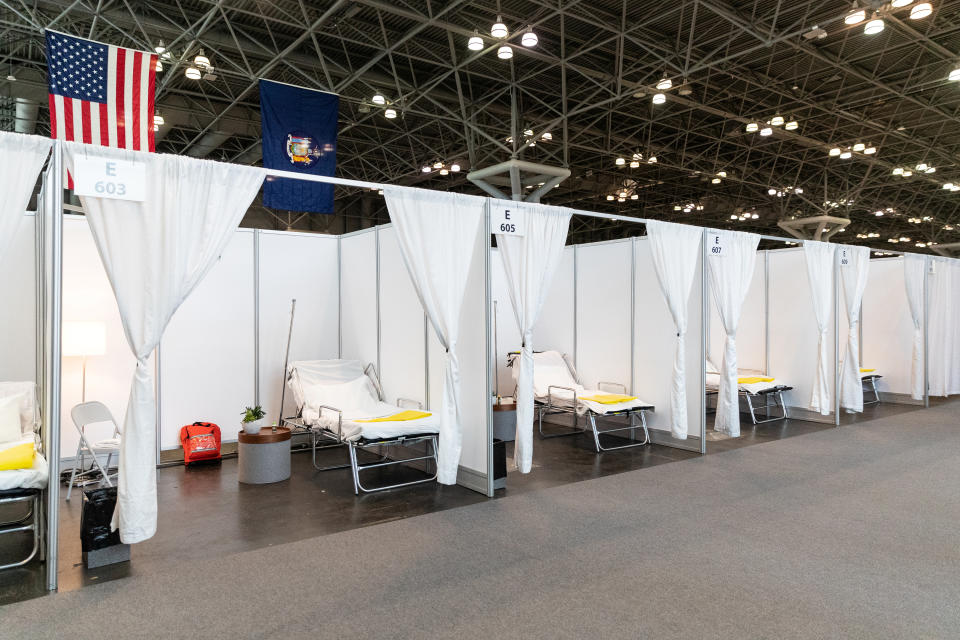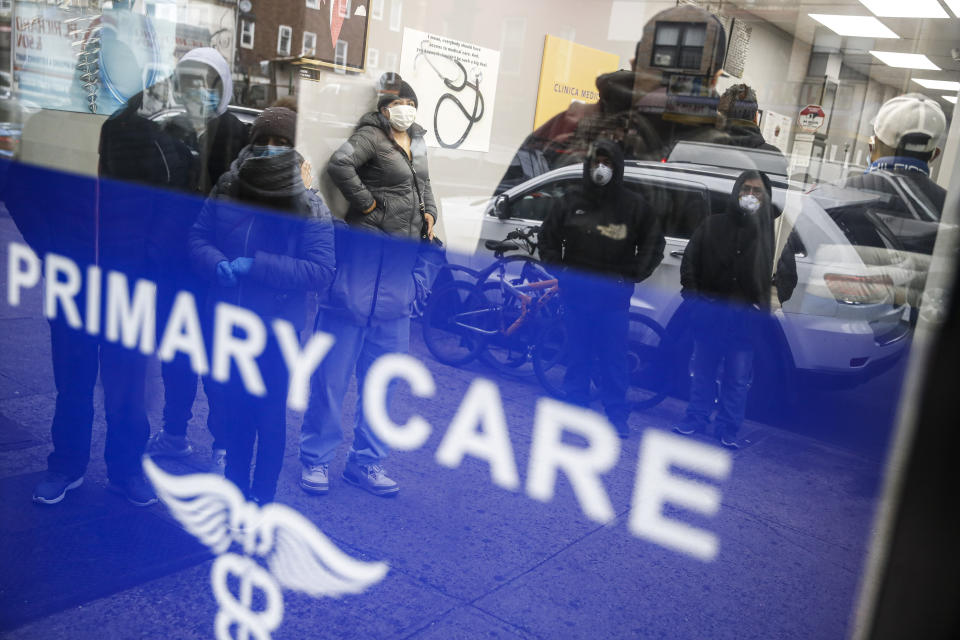The coronavirus pandemic is straining hospitals, but many medical school grads can't get jobs
As U.S. cases of COVID-19 increase, a shortage of ventilators, medical equipment and health care workers has captured nationwide attention. Some New York nurses have resorted to garbage bags in lieu of medical gowns and New York Gov. Andrew Cuomo has asked retired physicians and nurses to consider returning to work. New York University, a top medical school, is allowing fourth-year students to start working immediately in hospitals.
Yet as the need for physicians has increased, each year many qualified medical school seniors fail to acquire a residency position in a hospital, a requirement for beginning a practice. The number of medical school graduates is increasing faster than the number of residency slots, thanks in part to a cap on federal funding for residency programs that has been in place for over 20 years. Without securing a residency, medical school graduates cannot go on to become physicians. Some find themselves in their mid-20s with hundreds of thousands of dollars in debt after eight years of higher education, earning a living driving for car services or as baristas.
The limited supply of residency positions could eventually lead to a physician shortage in the U.S., authorities warn.
The COVID-19 pandemic “is really shining a very bright light on this deficiency that’s been present for far too long,” Dr. Monya De, an internist in Los Angeles, told Yahoo News.

A 2019 report by the Association of American Medical Colleges projected that the demand for physicians will grow faster than supply, leading to a total shortfall of up to 121,900 physicians by 2032.
“No matter how much ground we make up in terms of increasing the number of medical students — which we have done over the last 15 years — if you don’t increase the number of residency positions, those students cannot go on and practice independently and take care of you, me, our neighbors and our families,” Dr. Atul Grover, executive vice president of the AAMC, told Yahoo News. “Creating more residency slots is only one part of a multipronged solution that we need to address the physician shortage, but it’s an important one.”
Every year, medical school seniors enter the National Resident Matching Program — or “the match.” An algorithm selects applicants for a residency based on how applicants and residency programs rank each other, but each year many applicants fail to match to a residency. This year’s Match Day, held on March 20, was the largest in history, according to the NRMP, which reported that 40,084 applicants submitted program choices (or ranking lists) for 37,256 positions.
“You have a lot of students who are unmatched who have been reporting working at delis, working as baristas. They might be teaching at a community college or something like that because they have an MD, but they can’t work clinically,” De said. “Service industry jobs are really common. Bartending, waitering or waitressing. There are a lot of unmatched students driving for Uber and Lyft, I will tell you that.”
Many who don’t match to a residency search for unfilled residency spots in the Supplemental Offer and Acceptance Program, also known as “the scramble.” This year, 1,897 positions were offered, according to the NRMP. Some of those who still fail to find a residency find jobs in pharmacy or research — a tough transition after years of study and hundreds of thousands of dollars spent in pursuit of becoming a physician.
“These are not bad students,” Dr. Kavita Patel, a Yahoo medical contributor who served as director of policy for the Office of Intergovernmental Affairs and Public Engagement during the Obama administration, said of fourth-year medical students who do not match with a residency program.
Before they can even apply to match with a residency, applicants need to pass several rigorous medical licensing exams.
“They come from really good schools, and things just don’t go as they planned. They either didn’t apply to the right places, or they set their ambitions too high. Often the people who don’t match applied into extremely competitive specialties.”
A survey by the AAMC found that 75 percent of medical school deans are concerned about the availability of residency slots nationally, and 44 percent expressed concern about their own incoming students’ ability to find residency positions of their choice after medical school.
With many residency positions relying on Medicare funding, part of the residency shortage stems from a cap on federal expenditures for hospital training programs, imposed by the Balanced Budget Act of 1997. Since then, residency positions across the U.S. have grown just 1 percent a year — far less than the increase in medical school graduates.
Some in Congress have attempted to address this with the Resident Physician Shortage Reduction Act of 2019, which would add 15,000 residency slots over five years. It was introduced in the House and Senate last year with bipartisan support, but so far there has been little movement in either chamber.
“We must be prepared to meet the future health care needs of citizens across the country,” Sen. John Boozman, a Republican from Arkansas who co-sponsored the bill, said in a statement to Yahoo News. “By gradually lifting the caps on Medicare-supported doctor training, we can create new residency training slots to prevent a shortfall of well-qualified doctors. This is important to the long-term health of our communities.
“Our current situation demonstrates the urgency to pass this bill.”
There is an ongoing debate over who should pay for residency programs. Some hospitals have supplemented the Medicare-funded residency programs by paying out of their own budgets, especially if they have a shortage in certain specialties.
“They have spent their own money, unreimbursed by the Graduate Medical Education (GME) support, to add residency slots for themselves. So they’ll get GME funding, but then they’ll add slots on top of that,” Patel explained. “California is probably the best example of this, because California has had such a growth in population in areas.”
“There are all sorts of other ways you can fund residency programs, including Medicaid and self-funding. But the majority are Medicare,” Patel said.
Federal funding for medical residencies has existed for as long as Medicare itself. The rationale for federal financing was that educational programs enhance the quality of care at hospitals, and that hospitals should receive additional compensation for treating patients under Medicare, which pays for services at a discounted rate. But since 1997, the amount that Medicare contributes to residencies has stagnated.
“Teaching hospitals really do pay the bulk of the cost of training each resident, and that ends up being ... about $160,000 per year,” Grover said. “On average, even for those physicians that Medicare is supporting, they’re only supporting $30,000 to $40,000 per year.”
The other big question is whether we need more doctors at all, with some suggesting that the answer to America’s health care troubles is not more physicians.
“There are experts, not just inside the government, that would argue that the AAMC estimate is just too inflated and it’s too high. Because they represent all the medical schools — of course they’re going to ask for more,” Patel said.
“The crux of this is, really, how many doctors do we need? The easiest thing to remember is we have about 300 physicians for every hundred thousand people. Some say that’s too many. Some say that’s too little. It just depends. What’s the right number? It’s a debate that’s a lofty policy debate, but it’s also a very real issue.”
Part of the problem is the distribution of residency trainees and, subsequently, new physicians. Rural hospitals tend to attract fewer applicants.
“I think it depends on whose perspective you have,” Patel said, pointing to locations like rural Iowa, where physicians are more difficult to come by. “If you were in that part of the country, you would probably argue, I need a medical school. I need a hospital. I need all of it. And then if you’re in Philadelphia, where there are so many hospitals and medical schools, one could argue, There are too many medical schools. Why don’t we have fewer medical schools?”

The primary care specialties, which include family medicine, internal medicine and pediatrics, have proved particularly difficult to fill.
“Generally speaking, U.S. MD medical school seniors do not apply in great numbers to the primary care specialties,” Barry Eisenberg, senior communications analyst at the NRMP, told Yahoo News.
Eisenberg said that of the 34,266 first-year positions that were offered this year, 17,135 were in the primary care specialties. Of those positions, 16,343 (or 95.4 percent) were filled, but only 7,369 (or 45.1 percent) were filled by graduates of U.S. medical schools. Many positions are filled by international applicants, including both non-U.S. citizens and U.S. citizens who studied abroad.
In addition to an overall shortfall of physicians by 2032, the AAMC report predicted a shortage of up to 55,200 primary care physicians. Lower pay, longer hours and physician burnout are all factors discouraging graduates from entering primary care, compared with more lucrative specialties.
But apart from primary care needs, Grover pointed to gaps in other specialties, such as surgeons, that are in need of more trained physicians as the baby-boomer generation ages and as health care needs evolve.
“I think what the current crisis has exposed is that we have been at a very tight supply,” Grover said. “People have said, ‘Well, maybe we can be more efficient. Maybe we can use more technology.’ All those things are great. All those things are important. But the challenge is when you’re at this tight of a supply, if anything goes wrong, with us collectively as a neighborhood, as a community, as a nation, people are going to suffer.”
“And so now is the time, late as it is, to resume paying for that additional training. Because we’re going to need it. When this crisis is over — and hopefully it’s soon — we’re still going to need those additional physicians out there.”
_____
Read more from Yahoo News:



